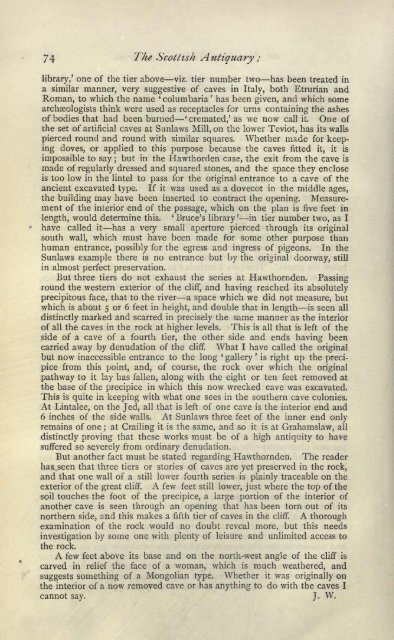Create successful ePaper yourself
Turn your PDF publications into a flip-book with our unique Google optimized e-Paper software.
74<br />
The Scottish Antiquary ;<br />
library,' one of the tier above viz. tier number two has been treated in<br />
a similar manner, very suggestive of caves in Italy, both Etrurian and<br />
Roman, <strong>to</strong> which the name *<br />
columbaria ;<br />
has been given, and which some<br />
archaeologists think were used as receptacles for urns containing the ashes<br />
'<br />
of bodies that had been burned<br />
cremated/ as we now call it. One of<br />
the set of artificial caves at Sunlaws Mill, on the lower Teviot, has its walls<br />
pierced round and round with similar squares. Whether made for keep-<br />
ing doves, or applied <strong>to</strong> this purpose because the caves fitted it,<br />
it is<br />
impossible <strong>to</strong> say; but in the Hawthorden case, the exit from the cave is<br />
made of regularly dressed and squared s<strong>to</strong>nes, and the space they enclose<br />
is <strong>to</strong>o low in the lintel <strong>to</strong> pass for the original entrance <strong>to</strong> a cave of the<br />
ancient excavated type. If it was used as a dovecot in the middle ages,<br />
the building may have been inserted <strong>to</strong> contract the opening. Measurement<br />
of the interior end of the passage, which on the plan is five feet in<br />
'<br />
'<br />
length, would determine this. Bruce's library in tier number two, as I<br />
have called it has a very small aperture pierced through its original<br />
south wall, which must have been made for some other purpose than<br />
human entrance, possibly for the egress and ingress of pigeons. In the<br />
Sunlaws example there is no entrance but by the original doorway, still<br />
in almost perfect preservation.<br />
But three tiers do not exhaust the series at Hawthornden. Passing<br />
round the western exterior of the cliff, and having reached its absolutely<br />
precipi<strong>to</strong>us face, that <strong>to</strong> the river a space which we did not measure, but<br />
which is about 5 or 6 feet in height, and double that in length is seen all<br />
distinctly marked and scarred in precisely the same manner as the interior<br />
of all the caves in the rock at higher levels. This is all that is left of the<br />
side of a cave of a fourth tier, the other side and ends having been<br />
carried away by denudation of the cliff. What I have called the original<br />
*<br />
but now inaccessible entrance <strong>to</strong> the long gallery '<br />
is right up the preci-<br />
pice from this point, and, of course, the rock over which the original<br />
or ten feet removed at<br />
pathway <strong>to</strong> it lay has fallen, along with the eight<br />
the base of the precipice in which this now wrecked cave was excavated.<br />
This is quite in keeping with what one sees in the southern cave colonies.<br />
At Lintalee, on the Jed, all that is left of one cave is the interior end and<br />
6 inches of the side walls. At Sunlaws three feet of the inner end only<br />
remains of one at ; Crailing it is the same, and so it is at Grahamslaw, all<br />
distinctly proving that these works must be of a high antiquity <strong>to</strong> have<br />
suffered so severely from ordinary denudation.<br />
But another fact must be stated regarding. Hawthornden. The reader<br />
has seen that three tiers or s<strong>to</strong>ries of caves are yet preserved in the rock,<br />
and that one wall of a still lower fourth series is plainly traceable on the<br />
exterior of the great cliff. A few feet still lower, just where the <strong>to</strong>p of the<br />
soil <strong>to</strong>uches the foot of the precipice, a large portion of the interior of<br />
another cave is seen through an opening that has been <strong>to</strong>rn out of its<br />
northern side, and this makes a fifth tier of caves in the cliff. A thorough<br />
examination of the rock would no doubt reveal more., but this needs<br />
investigation by some one with plenty of leisure and unlimited access <strong>to</strong><br />
the rock.<br />
A few feet above its base and on the north-west angle of the cliff is<br />
carved in relief the face of a woman, which is much weathered, and<br />
suggests something of a Mongolian type. Whether it was originally on<br />
the interior of a now removed cave or has anything <strong>to</strong> do with the caves I<br />
cannot say. J. W,

















